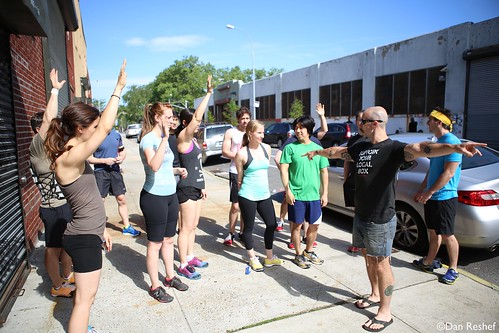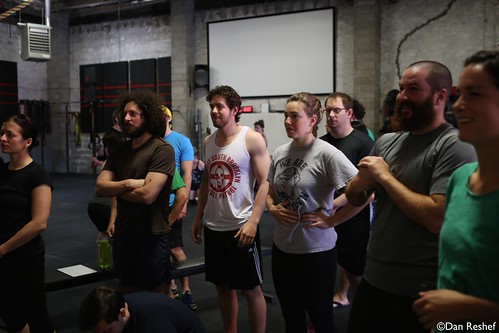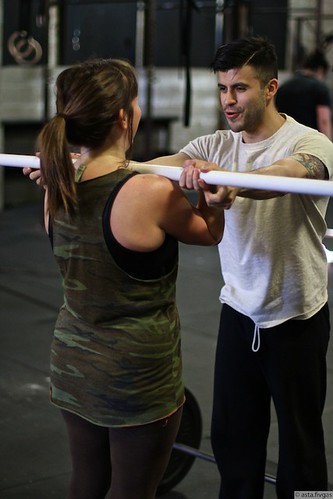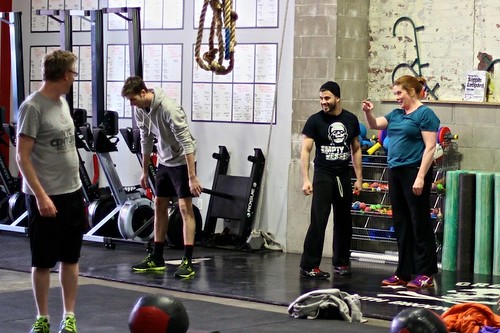CrossFit Group Class Coaching Expectations: Communication
 Monday, June 16, 2014 at 12:00AM
Monday, June 16, 2014 at 12:00AM 
In last week’s article, I wrote about a brainstorming session a few years ago that led me to identify my expectations for my coaches during group classes. I wanted those expectations written in concrete terms so I could communicate with my staff more clearly and get all of us on the same page. As I stated before, I believe there are underlying principles of coaching that are consistent regardless of coaching style, personality, or context, and I now have a basic document that functions as a "job description” for my coaches. Last week, we talked about the importance of timeliness, and today, we’re going to address effective communication.
When I first started teaching group classes after years of training clients one-on-one, I quickly realized that communicating with a class was an entirely different skill that I needed to acquire and develop. Working with groups necessitates clear and effective public speaking skills. Your success coaching at or owning an affiliate is largely predicated on your ability to communicate with groups to accomplish the training goals of a class in a way that engages every member.
Below, I’ve listed and discussed the five expectations for CFSBK’s coaches that fall within the arena of communication during group classes.
Communication
1. Coaches should clearly and concisely brief every class on the workout and scaling options at the whiteboard before each major segment. This is an opportunity to focus on one to three points of performance.
Getting everyone on the same page about each portion of the day's training will enable you to run a tight ship. For a further breakdown of this, check out the articles "Using Times Stamps to Manage Group Classes" and "How to Run Large Group Classes Part 1." Whenever a group of athletes walks away from the board during a group class, they should understand the following:
- How to structure of the training segment
- How to modify movements or weights for their needs
- How long they'll have to complete their work
- Where exactly they should organize themselves when they break out
It can seem like a lot of ground to cover, but if a coach doesn’t figure out how to communicate these points well, they create ambiguity amongst your members, which leads to serious inefficiencies in the flow of the class. The coach then will have to clean up those inefficiencies later when she or he should be coaching movement. Simply put, coaches should learn how to communicate instructions in a clear and concise manner, so they can focus on what they signed up to do: coach.
Additionally, the white board review is an opportunity for the coach to discuss or demo a point of performance, such as weight distribution during a power clean or how to properly hang from a bar to avoid ripping calluses. Whether it's a more nuanced topic (like how to get into the right headspace for a 2K row), or something simple (like example warm-up progressions for a 300 and 115lb deadlift), the point is that coaches have an opportunity to add a little extra value and education to the brief. I would estimate these mini-lectures at CFSBK last anywhere from 30 seconds to a minute and over time they’ve helped build intelligent trainees, who are easier to coach and ultimately more successful as athletes.
 2. Coaches should connect individually with every athlete at least once, if not twice, each class.
2. Coaches should connect individually with every athlete at least once, if not twice, each class.
For anyone who works at an affiliate where classes are small, say 5-10 people on average per class, this point may seem so intuitive it's not worth mentioning. There are however a huge number of affiliates regularly running over 20-person classes. In these classes, if you're not mindful about it, people slip through the cracks in terms of getting direct coaching.
At CFSBK, we don't want people coming to our classes and not having a coach communicate directly with them. Even if the person is consistently moving really well, they should get reassurance on their training and behavior to encourage more of it. In large classes, our coaches tend to divide the athletes in half and focus on one group so they get more exposure to the same people. One coach watching 10 specific people is going to provide more valuable and consistent feedback than two coaches wandering a room of 20 athletes. If coaches are wandering, they may assume that the other coach already talked to a particular person when in fact no one ever did—and that person ends up missing out on the training experience they should expect. A little mental organization and direct communication about responsibilities goes a long way here.
3. Coaches should project confidence and interest both the entire class and individuals.
A coach needs to earn the respect of their athletes by both being properly prepared for the role and by demonstrating confidence in their abilities and voice. A coach will not win over a group of type-A CrossFitters by being sheepish. Coaches need to turn it on and become a bigger version of themselves when leading a class. Many new coaches struggle with public speaking, and being bold in front of a large group of people might be a terrifying prospect. My advice to my coaches? Fake it till you've got it. In time, it will feel natural and instinctive.
 If you’re a coach, ask yourself: are you tuned into your class on an individual and communal level, or are you mentally "out to lunch" and simply going through the motions? Athletes will notice when coaches don't really care and in turn, athletes will lose respect and interest in that person as a professional. The coach should so obviously be interested in helping people that athletes know they can come up to them with questions or comments, no matter how basic or silly they might seem. We have the luxury of being a highlight of the day for most of the people that come through our doors. As a coach, you should be excited about your members and tune into their needs.
If you’re a coach, ask yourself: are you tuned into your class on an individual and communal level, or are you mentally "out to lunch" and simply going through the motions? Athletes will notice when coaches don't really care and in turn, athletes will lose respect and interest in that person as a professional. The coach should so obviously be interested in helping people that athletes know they can come up to them with questions or comments, no matter how basic or silly they might seem. We have the luxury of being a highlight of the day for most of the people that come through our doors. As a coach, you should be excited about your members and tune into their needs.
4. Coaches should communicate loudly and clearly, considering vocal projection and orientation relative to audience.
A typical coach is often competing with the background noise of music, clanging barbells, other coaches teaching, and the general chatter of people socializing outside the class. Coaches who work at larger affiliates have to project their voice to everyone in their class. We often prep our coaches by having them teach a progression while the music is blasting and their practice trainees are on the other side of the room, which helps them realize how loud they need to be in order to communicate with the whole class, given the acoustics and size of our gym.
Speaker orientation is also critical given how many movements we demo and the varied layouts of lifting segments, which place people in different positions throughout our facility. For example, if you've got a class of 15 people and you're demoing deadlifts at the front of the room while your face is pointed to the floor, chances are the folks in the back are going to be unable to hear what you're saying. Coaches should take into account where people are listening from within the gym and actively project to them.
 5. Coaches should facilitate inclusive and friendly interaction with the entire class, and between individuals.
5. Coaches should facilitate inclusive and friendly interaction with the entire class, and between individuals.
The type of engagement implied here takes coaches to what I consider the next level of coaching—beyond teaching movement, and even beyond running an efficient class where the coach steers the atmosphere the room. This is often achieved by the coach filling out their role with their particular personality, by cracking jokes, engaging directly with the athletes during the Question of the Day, and generally letting the best parts of themselves shine through. Doing this enables group classes to be more interesting and personal for everyone, and is crucial for building a sense of community within your affiliate.
At CFSBK, we also want our coaches to help facilitate connections between members themselves. Little things go a long way in providing your members with a truly novel and stimulating group class experience. For example, remind everyone to know the names of people they’re sharing a rack with, or ask someone who finished the WOD already to go count for and support someone still working.
Stay tuned for the next installment in which we'll address coaching guidelines!
______________________
What is important to you when it comes to communicating with athletes?

Reader Comments (1)
Are you looking for the top TNPSC coaching institution in Chennai? The best TNPSC coaching center in Chennai, Shine Academy, offers the best online coaching programs. Our TNPSC Academy in Chennai provides TNPSC Group Exams with specialized instruction and training, delivered by skilled and effective staff. Everyone knows that We Shine Academy is the best TNPSC exam coaching center in Chennai, not just in Chennai but the entire state, with a proven track record of success.